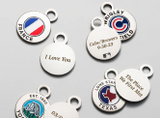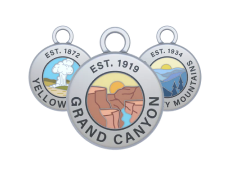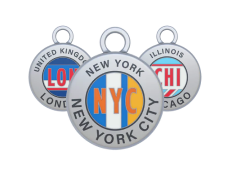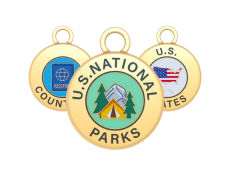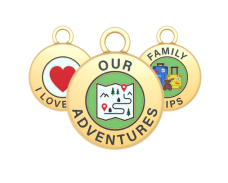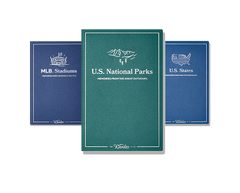
Key Takeaways:
- Diverse Hiking Trails: There are options for all skill levels, each offering stunning vistas and immersive experiences into the canyon’s depths.
- Thrilling Rafting Adventures: Paddle down the Colorado River to uncover hidden waterfalls and serene gorges.
- Unforgettable Sunrises And Sunsets: Visit iconic points where nature’s beauty leaves a lasting impression on your soul.
Standing on the edge of the Grand Canyon is a moment you never forget. The scale is massive, the colors shift by the hour, and every view makes you want to stare for hours. Whether you're here to hike below the rim, raft the Colorado River, or catch a sunrise that stops you, the canyon offers endless ways to make your visit unforgettable.
The Grand Canyon is a place to challenge yourself and create stories you'll carry forever. At The Wander Club, we believe in turning those stories into keepsakes so you can remember every adventure long after you head home.
In this guide, you’ll find the top 10 things to do at the Grand Canyon, from classic hikes to iconic overlooks. Let us help you make the most of your trip.
1. Hiking The Grand Canyon: Top Trails for All Levels
Whether you're looking for fun things to do at the Grand Canyon on a quick day trip or planning a bigger adventure, there’s a path made for you.
Bright Angel Trail
This iconic South Rim trail is popular for good reason. Bright Angel Trail winds steadily toward the Colorado River with well-maintained switchbacks and reliable shade stops. Many hikers turn around at Mile-and-a-Half Resthouse or Three-Mile Resthouse, making it perfect for those who want a taste of the canyon without committing to a full descent. Remember: The farther you go down, the harder it is to return, so save some energy for the climb back up.
South Kaibab Trail
South Kaibab Trail is all about views. Following a ridgeline, it offers wide-open panoramas almost every step of the way. Ooh Aah Point is just under a mile down and offers exactly what the name promises: breathtaking vistas worth every step. Cedar Ridge and Skeleton Point provide even bigger rewards for more adventurous hikers. Just be aware there’s no water on this trail, so bring plenty. Canyon heat is no joke!
Rim Trail
The Rim Trail is a must if you want a leisurely, easy hike. It stretches around 13 miles along the South Rim, with sections that are paved and accessible, making it great for families, strollers, and those looking for a more relaxed experience. The portion between Mather Point and Yavapai Point is especially scenic at sunset.
North Kaibab Trail
On the less crowded North Rim, the North Kaibab Trail offers a wilder side of the Grand Canyon. A short hike to Coconino Overlook gives you beautiful views and a sense of solitude that’s hard to find elsewhere. Wildflowers brighten the path in early summer, adding an unexpected splash of color.
No matter which trail you choose, each step adds a new chapter to your travel story. Just remember to check the trail and weather conditions before you head out. Storms and heat can change plans quickly, so you must be prepared. If you’re ready to celebrate those miles and memories, The Wander Club’s travel tokens are a perfect way to carry a piece of your journey.
Looking for more ideas beyond the canyon? Check out our guides on things to do at Yellowstone National Park and things to do in Yosemite for even more inspiration. And if you're shopping for someone who loves to wander, don't miss our best travel gifts for her suggestions – your go-to list for kindred spirits ready to collect their next adventure.
2. Rafting The Colorado River
Rafting the Colorado River is one of the most thrilling ways to experience the Grand Canyon. Whether you choose a half-day adventure or a weeklong journey, you’ll trade the crowded overlooks for towering canyon walls, hidden waterfalls, and the rush of whitewater rapids. Between the heart-pounding sections, there are calm stretches where you can look up at ancient rock layers and truly feel the scale of this natural wonder.
Guided trips make it accessible to most adventurers, offering expert navigation, gear, and stories about the canyon’s geology and history. From spotting bighorn sheep on the cliffs to feeling the spray on a hot summer day, every moment is a new perspective on a place that’s already unforgettable.
3. Sunrise And Sunset Points: Nature’s Spectacular Show
Catching sunrise and sunset at the Grand Canyon is an experience that sticks with you long after you’ve left the rim. Spots like Mather Point, Yaki Point, Hopi Point, and Desert View offer some of the best front-row seats. The canyon slowly shifts from deep blues and purples to warm golds and reds at sunrise as the first light spills over the rock layers. It’s almost meditative and worth the early wake-up call.
As the day winds down, sunset brings its own magic. Bring a warm layer, a thermos of something hot, and settle in. These moments remind us why we explore in the first place.
4. Visiting Grand Canyon Village: History And Heritage
Grand Canyon Village offers a blend of history and striking canyon views all in one place. Here, you can step into El Tovar Hotel – an iconic lodge from 1905 that still feels like a glimpse into early 20th-century travel. Nearby, Hopi House showcases traditional Native American artistry and allows visitors to support local crafts. You’ll also find Kolb Studio, once home to adventurous photographers capturing the canyon’s raw spirit, now turned into an inspiring gallery.
Wandering these paths, you’ll catch echoes of old train arrivals and early explorers eager to see the canyon for the first time. The village is about connecting to a shared heritage and seeing how this remarkable place has welcomed travelers for over a century. Whether you stop for a quick visit or linger on a porch bench, the stories here make every stop feel like part of something bigger.
5. Mule Rides Into The Canyon
Riding a mule into the canyon lets you move at a steady, thoughtful pace while taking in views you simply can’t see from above. These guided trips follow historic trails, with experienced wranglers leading and sharing insights about the landscape and its history.
You can choose a shorter ride along the rim for a gentle introduction or go all-in with a full day or overnight journey down to Phantom Ranch at the bottom of the canyon. Along the way, you’ll pass towering rock walls and cool pockets of shade where the canyon feels especially alive. It’s a classic adventure that combines the thrill of discovery with a sense of connection—both to the land and to a tradition that’s been part of canyon exploration for over a century.
6. Biking In The Grand Canyon
While you can’t take a bike down into the canyon, cycling along the rim offers a fun and refreshing way to explore this iconic landscape. The South Rim has a network of paved roads and greenway paths for relaxed, scenic rides with Instagram-worthy views around every curve. One popular option is the Hermit Road route, which is closed to private vehicles most of the year. This gives cyclists a peaceful, car-free stretch along some of the canyon’s best overlooks.
Bikes are available for rent in Grand Canyon Village, so you don’t have to bring your own gear. Whether cruising to watch the sunrise at Hopi Point or stopping at shaded viewpoints for pictures, biking invites you to slow down and experience the park in a different rhythm. It’s a laid-back adventure that balances a sense of freedom with the simple joy of taking in each vista at your own pace.
7. Setting Up Camp
Camping at the Grand Canyon turns a day visit into an immersive experience, letting you soak in starry skies and desert mornings long after most visitors have headed home. Mather Campground is the most popular choice in the South Rim. It is open year-round and offers tent and RV sites close to Grand Canyon Village, with easy access to shuttle stops and rim trails. Desert View Campground, farther east, is a smaller, seasonal option that feels more remote and offers stunning sunrise views.
If you’re looking for a more rugged adventure, backcountry camping below the rim requires a permit and solid preparation. However, it rewards you with unforgettable nights deep in the canyon, such as at Bright Angel Campground near Phantom Ranch. Wherever you pitch your tent, expect chilly nights even in summer, and always follow Leave No Trace principles to help protect this incredible landscape for future travelers.
8. Canyon Nights: When The Sky Steals The Show
The Grand Canyon is one of the best places in the U.S. to look up and see the night sky in its full glory. As soon as the sun dips below the horizon, the high desert air and minimal light pollution reveal a canopy of stars that feels endless. From popular South Rim viewpoints like Mather Point or Desert View, you can catch the Milky Way stretching across the sky, watch meteor showers, or simply enjoy the company of distant planets.
The darkness makes stargazing even better if you’re visiting during a new moon. Rangers sometimes offer night sky programs during peak seasons, helping visitors identify constellations and learn about the canyon’s geology under starlight. Dress warm and bring a blanket or thermos of something hot since temperatures drop quickly after dark. Stargazing is one of the best ways to feel part of something much bigger than yourself. And when you’re back home, you can commemorate the experience by personalizing the back of your Grand Canyon token from The Wander Club with the date you went, the name of a constellation you spotted, or the people you shared it with – all right from the listing.
9. Helicopter Flight Over The Grand Canyon
Soaring above the Grand Canyon by helicopter gives you a whole new perspective. From the air, the vast layers of rock, winding river corridors, and hidden side canyons unfold in a way that walking trails simply can’t offer. Flights typically depart from the South Rim or nearby towns, offering options ranging from short scenic loops to more extended tours with views of the North Rim and beyond.
You’ll glide over towering buttes and deep chasms, watching the Colorado River snake far below. Headsets allow for narration during the flight, sharing geological and cultural stories that add even more depth to what you’re seeing. For travelers who want to capture the scale and drama of the canyon in one moment, a helicopter ride is a thrilling and memorable way to round out the adventure.
10. Walking The Skywalk
For a different kind of thrill, head to the Grand Canyon’s West Rim to experience the Skywalk. This horseshoe-shaped glass bridge extends 70 feet from the canyon’s edge, letting you look straight down into the depths, about 4,000 feet below. It’s not for the faint of heart, but it offers a one-of-a-kind chance to feel like you’re floating above the vast landscape.
Sturdy and durable structure, designed to handle strong winds and heavy crowds. Visitors must wear special booties to protect the glass surface for extra safety. Whether you’re looking to push past a fear of heights or get a new perspective on the canyon’s sheer scale, the Skywalk is an accessible way to connect with this natural wonder.
Final Thoughts
The Grand Canyon stays with you. From feeling the rush of the Colorado River to tracing constellations in the night sky, each moment becomes part of your personal story. These memories deserve more than a quick snapshot or a passing thought.
At The Wander Club, we believe in keeping those stories alive. Our handcrafted, tarnish-resistant tokens let you personalize each keepsake with a date, a special word, or a reminder of who you shared it with. Every token helps you carry a piece of your journey wherever you go, from national parks and landmarks to countries and cities.
Because travel memories shouldn’t fade, from rim to river, let your Grand Canyon adventure become something you hold close – and let your travel token be a timeless reminder of the places that shaped you and the adventures still waiting.
Read also:
- 25 Fun Facts About National Parks
- The Ultimate Zion Bucket List: What To Do And Where To Go
- Planning The Ultimate Baseball Road Trip
Frequently Asked Questions About Things To Do At The Grand Canyon
What is the best time of year to visit the Grand Canyon?
Spring (March to May) and fall (September to November) are ideal. Temperatures are milder, crowds are smaller, and the canyon’s colors pop – perfect for photos and relaxed exploring. Summer is the busiest and hottest, while winter offers quiet trails and snow-dusted views for those who like a more peaceful experience.
Are there guided tours at the Grand Canyon?
Absolutely! You’ll find guided hiking, biking, rafting, mule rides, and ranger-led programs that dive into geology, history, and local wildlife. Whether you want expert insight or the liveliness of traveling in a group, there’s an option for every adventurer's style.
Can I hike from the rim to the river in one day?
It’s possible but not recommended for most visitors. The elevation change is intense, and the hike back up is challenging, especially in summer heat. Park rangers suggest turning it into a multi-day adventure, staying overnight at Phantom Ranch or Bright Angel Campground if you want to go all the way.
What should I pack for a trip to the Grand Canyon?
Bring sturdy hiking shoes, a sun hat, sunscreen, layers for changing weather, plenty of water, and energizing snacks. A camera or journal helps capture the highlights, and an engraved token from The Wander Club is a great way to mark the moment. Always check the forecast—desert temperatures can fluctuate daily to night.
Do I need a permit to hike the Grand Canyon?
You don’t need a permit for day hikes on the rim or partial descents. But you'll need a backcountry permit for overnight trips below the rim (like camping at the river). These fill up fast, so plan ahead.
Is the Grand Canyon suitable for children?
Yes! There are junior ranger programs, accessible viewpoints, and easy trails for families. Just watch kids near the edges – many spots don’t have railings. Sharing the canyon with your family is a fantastic way to spend quality time together.
What wildlife can be seen at the Grand Canyon?
Visitors often spot mule deer, bighorn sheep, ravens, and the occasional California condor soaring overhead. Squirrels are everywhere and bold around snacks. Each encounter is a reminder to respect wildlife and keep these places pristine for future explorers.
